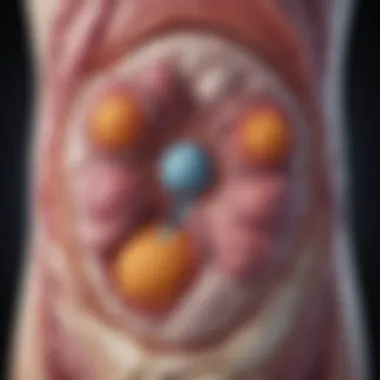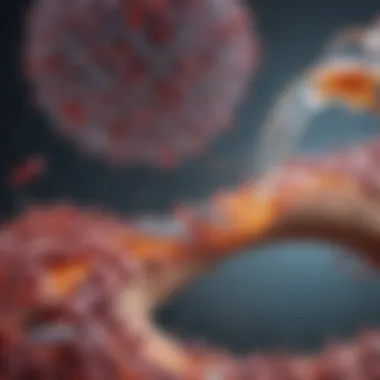Understanding Pancreas Hormones in Human Physiology


Intro
The pancreas plays a vital role in human physiology through its production of hormones. These hormones, primarily insulin, glucagon, and somatostatin, are crucial for regulating various metabolic processes. Understanding how these hormones function provides insight into energy metabolism and homeostasis.
Research Overview
Key Findings
Recent studies highlight the interconnected roles of pancreas hormones in maintaining metabolic balance. Insulin lowers blood glucose levels, while glucagon increases them, creating a complex feedback system. Somatostatin, on the other hand, modulates the secretion of both insulin and glucagon.
These findings underscore the importance of the pancreas in regulating energy usage within the body, illustrating the delicate balance required for optimal physiological function.
Study Methodology
Research in this field often includes:
- In vitro experiments examining hormone secretion in pancreatic cells.
- Clinical studies on individuals with diabetes to assess hormonal responses to various stimuli.
- Animal models to study the physiological effects of hormone manipulation on metabolism.
Background and Context
Historical Background
The discovery of insulin in the early 20th century marked a significant milestone in understanding pancreatic hormones. This breakthrough laid the groundwork for treating diabetes, which was once a terminal illness. Over the decades, ongoing research has detailed the contributions of glucagon and somatostatin to human physiology.
Current Trends in the Field
Currently, research is focusing on:
- The role of pancreatic hormones in obesity and metabolic syndrome.
- New therapeutic approaches that target hormonal pathways.
- The implications of hormone dysregulation in diseases like diabetes and other metabolic disorders.
Understanding these trends is critical for developing advanced treatment strategies and improving overall health outcomes.
Prelude to Pancreatic Hormones
Understanding the role of pancreatic hormones is essential for comprehending human physiology. The pancreas is not just a digestive organ; it is a vital part of the endocrine system. Its hormones, primarily insulin, glucagon, and somatostatin, regulate various metabolic processes. This regulation is crucial for maintaining energy balance and homeostasis in the body.
The intricate functions of these hormones influence how the body utilizes glucose, fats, and proteins. Each hormone has unique properties and actions that contribute to overall metabolic health. Insulin lowers blood sugar levels, while glucagon raises them, creating a delicate balance.
Overview of the Pancreas
The pancreas is located in the abdomen, behind the stomach. It serves two main functions: exocrine and endocrine. The exocrine function involves the secretion of digestive enzymes. These enzymes reach the intestines to aid in food digestion. On the other hand, the endocrine function involves the production and release of hormones directly into the bloodstream.
These hormones come from specialized cells called islets of Langerhans. These clusters of cells include alpha, beta, and delta cells. Each type of cell produces a specific hormone. Together, they orchestrate the body’s metabolism in response to various stimuli, such as food intake and energy expenditure.
Definition of Hormones
Hormones are chemical messengers that coordinate different functions of the body. They are produced by glands and released into the bloodstream to regulate physiological processes. In the case of pancreatic hormones, their primary role is to control glucose metabolism, promote energy storage, and support physiological responses to stress.
The actions of hormones can be broad and far-reaching. Their influence can be seen in how our bodies respond to changes in diet, activity levels, and overall health. Understanding these hormones provides crucial insights into metabolic conditions, such as diabetes and obesity.
Major Hormones Produced by the Pancreas
The pancreas is a vital organ that plays an essential role in the endocrine system through the secretion of hormones. The major hormones produced by the pancreas include insulin, glucagon, and somatostatin. Each of these hormones serves unique functions that contribute significantly to metabolic homeostasis. Understanding the functions and interactions of these pancreatic hormones is crucial for appreciating their impact on human physiology.
Insulin
Function of Insulin
Insulin is a hormone produced by the beta cells of the pancreas. Its main function is to lower blood glucose levels. By facilitating the uptake of glucose into cells, insulin plays a significant role in maintaining energy balance. This function is especially important after meals when blood sugar levels rise. Insulin is often viewed as a key player in metabolic processes, making its study essential for understanding how our bodies regulate energy.


Mechanism of Insulin Action
The mechanism of insulin action involves the binding of insulin to its receptors on target cells, which activates a cascade of intracellular processes. This activation leads to the translocation of glucose transporter proteins to the cell membrane, allowing more glucose to enter the cell. The efficiency of this mechanism is critical for regulating blood glucose levels. The understanding of insulin action informs many therapeutic strategies for managing diabetes, making it a topic of considerable interest.
Physiological Effects
Insulin has widespread effects on various physiological processes. In addition to facilitating glucose uptake, it encourages lipogenesis and protein synthesis. These effects not only impact energy storage but also influence overall metabolic health. The regulation of these physiological effects is crucial, as imbalances can lead to metabolic disorders, emphasizing the importance of insulin in human health.
Glucagon
Function of Glucagon
Glucagon is another critical hormone produced by the alpha cells of the pancreas. It serves primarily to raise blood glucose levels, counteracting the effects of insulin. Glucagon works by promoting glycogenolysis and gluconeogenesis in the liver, ensuring a steady supply of glucose during fasting states. This function is vital for maintaining energy levels during periods without food intake.
Mechanism of Glucagon Action
The mechanism of glucagon action is distinct from that of insulin. When glucagon binds to its receptors, it primarily activates intracellular signaling pathways that stimulate the release of glucose from liver stores. This pathway is crucial for enabling the body to respond to drops in blood sugar, particularly during fasting or strenuous exercise. Its understanding is essential for developing treatments for hypoglycemia and other metabolic disorders.
Physiological Effects
The physiological effects of glucagon include increased blood sugar levels and promotion of fat breakdown through lipolysis. These effects are complementary to those of insulin, ensuring a balanced metabolic state. By understanding these effects, we can better assess the role of glucagon in conditions like diabetes, where its functions may become dysregulated.
Somatostatin
Function of Somatostatin
Somatostatin, produced by the delta cells of the pancreas, has a more inhibitory role compared to insulin and glucagon. Its primary function is to suppress the release of other hormones, including insulin and glucagon. This regulatory function is important for maintaining the balance of hormone levels in the bloodstream, reflecting its overall significance in endocrine regulation.
Mechanism of Somatostatin Action
The mechanism of somatostatin action involves binding to specific receptors on target cells, which inhibits hormone secretion. This action helps fine-tune the physiological responses to nutrients and hormones, preventing hormonal overload. Recognizing this mechanism is vital for understanding disorders where regulatory pathways become disrupted.
Physiological Effects
Somatostatin affects multiple systems beyond just glucose regulation. By inhibiting the release of growth hormone and thyroid-stimulating hormone, it plays a role in overall growth and metabolism. Understanding these physiological effects aids in comprehending conditions that arise from hormonal imbalances, thus underlining the importance of somatostatin in human health.
Overall, the major hormones produced by the pancreas—insulin, glucagon, and somatostatin—interact complexly to regulate metabolism and maintain homeostasis. Their study is essential for advancing our understanding of metabolic disorders and developing effective treatments.
The Regulation of Pancreatic Hormones
The regulation of pancreatic hormones is a critical feature in ensuring metabolic balance and maintaining homeostasis. The pancreas produces several hormones that significantly influence various physiological processes. This section will discuss the regulatory mechanisms involved in the secretion of these hormones, specifically focusing on hormonal and neural regulation. Understanding these mechanisms is essential for grasping how the body adapts to changes in metabolism and energy requirements.
Hormonal Regulation
Hormonal regulation refers to the processes by which hormones are released into the bloodstream in response to various stimuli. This mechanism is crucial as it ensures that the levels of insulin, glucagon, and somatostatin are finely tuned to the body's needs, particularly concerning nutrient availability.
Feedback Mechanisms
Feedback mechanisms are pivotal in maintaining the proper functioning of the endocrine system. They operate mainly through negative feedback, a process where the output of a system suppresses or limits the processes that lead to its production. For example, when blood glucose levels rise, insulin is secreted to facilitate glucose uptake by tissues. Once blood sugar levels normalize, insulin secretion decreases. This characteristic makes feedback mechanisms efficient and vital in preventing extremes in hormone levels.
The unique feature of feedback mechanisms lies in their ability to self-regulate. They retain balance by adjusting hormone production based on the body's current metabolic state. That reduces the risk of complications associated with hormone excess or deficiencies, making feedback mechanisms a beneficial aspect of pancreatic hormone regulation.
Role of Blood Glucose Levels
Blood glucose levels are central in the regulation of pancreatic hormones. They respond to nutrient intake, physical activity, and hormonal signaling. When glucose levels increase after a meal, the pancreas releases insulin to facilitate glucose absorption into cells. Conversely, when glucose levels drop too low, glucagon is secreted to stimulate the liver to release stored glucose.
A key characteristic of blood glucose regulation is its direct link to metabolic pathways. By focusing on blood glucose levels, the body can quickly adjust hormone production to respond to changes in energy supply. This link is beneficial for preventing both hyperglycemia and hypoglycemia, conditions that can have severe health implications. However, the dependence on blood glucose levels also means that disruptions in this system can lead to metabolic disorders like diabetes or hypoglycemia, indicating its critical role in overall health.
Neural Regulation


Neural regulation refers to the influence of the nervous system on hormone secretion. This mechanism is less direct than hormonal regulation but plays a significant role in adjusting hormone levels based on immediate environmental and emotional cues.
Autonomic Nervous System
The autonomic nervous system (ANS) significantly influences pancreatic hormone secretion. The ANS comprises two parts: the sympathetic and parasympathetic systems. The sympathetic system often responds to stress by promoting glucagon secretion, while the parasympathetic system encourages insulin release during rest and digestion. This duality helps the body navigate various stressors and metabolic demands effectively.
A key feature of the ANS is its rapid response time. Unlike hormonal signals, which can take longer to effect change, neural signals can trigger changes in pancreatic hormone secretion almost immediately. This characteristic is beneficial in acute situations, such as during exercise or stress, where body energy demands change suddenly. However, an overactive sympathetic response can lead to issues like insulin resistance, highlighting the need for balance in this regulatory system.
Influence of the Central Nervous System
The central nervous system (CNS) also plays a crucial role in regulating pancreatic hormones. The hypothalamus and other brain regions integrate signals related to hunger, food intake, and energy balance. When these centers detect a need for energy, they signal the pancreas to adjust hormone output accordingly.
One unique aspect of CNS influence is its ability to link psychological factors with physiological responses. Stress, anxiety, and even the sight or smell of food can affect hormone secretion. This connection underscores the importance of mental health in overall metabolic regulation. However, this reliance on the CNS can lead to complications as stress and emotional states may lead to dysregulation of insulin and glucagon secretion, further complicating conditions like diabetes.
In summary, the regulation of pancreatic hormones is a complex but essential aspect of maintaining metabolic homeostasis. Both hormonal feedback mechanisms and neural inputs work in concert to ensure that hormone levels are appropriate for the body’s needs.
Impact of Pancreatic Hormones on Metabolism
Understanding the impact of pancreatic hormones on metabolism is crucial for comprehending their role in human physiology. These hormones directly influence how the body utilizes glucose, lipids, and proteins. Insulin, glucagon, and somatostatin work in concert to maintain metabolic balance. This section will explore how these hormones adaptively regulate energy stores and usage. The interplay between these hormones and metabolic pathways helps explain conditions like diabetes.
Role in Glucose Homeostasis
Insulin and Glucose Uptake
Insulin is vital for glucose uptake in cells. Its primary role is to promote the transport of glucose from the bloodstream into cells, particularly muscle and adipose tissue. Insulin facilitates this process by stimulating glucose transporter proteins, such as GLUT4. This characteristic makes insulin essential for regulating blood sugar levels, preventing hyperglycemia.
The unique feature of insulin is its quick action following food intake. After a meal, insulin secretion increases, resulting in enhanced glucose uptake. This immediate response helps maintain stable glucose levels. Conversely, if insulin action is impaired, like in diabetic conditions, it can lead to excessive glucose levels in the blood.
Glucagon and Glycogenolysis
Glucagon serves an opposing function to insulin, primarily working to increase blood glucose levels. When blood sugar drops, glucagon is released from the alpha cells of the pancreas. This hormone stimulates glycogenolysis, the process of breaking down glycogen stores in the liver into glucose. This action is essential during fasting or periods of low food intake.
A key characteristic of glucagon is its rapid impact on increasing blood glucose levels. It serves as a counter-regulatory hormone that balances insulin's effects. However, excessive glucagon can lead to elevated glucose levels, contributing to conditions like diabetes.
Influence on Lipid Metabolism
Insulin and Lipogenesis
Insulin plays a major role in lipogenesis, the process of converting carbohydrates into fat. Here, insulin promotes the creation of fatty acids and triglycerides, facilitating fat storage. This characteristic is significant in energy balance since excess energy can be stored for future use.
The unique aspect of insulin-induced lipogenesis is its role in fat storage after meals. Following carbohydrate intake, insulin levels surge, leading to increased fat storage. However, chronic high insulin levels may lead to obesity and other metabolic disorders.
Glucagon and Lipolysis
Glucagon also influences lipid metabolism, specifically promoting lipolysis. This process breaks down stored fats into free fatty acids, which are then released into the bloodstream for energy use. When glucagon rises, especially during fasting, lipolysis becomes predominant.
A vital characteristic of glucagon in this regard is how it provides energy during periods of low carbohydrate intake or fasting. This function makes glucagon essential for managing the body’s energy demands. However, overactivation can lead to excessive fat breakdown, which may have implications for metabolic health.
Protein Metabolism
Role of Insulin in Protein Synthesis
Insulin is not only crucial for carbohydrate and fat metabolism but also plays a significant role in protein synthesis. By promoting the uptake of amino acids into cells, insulin facilitates protein synthesis essential for growth and repair. This characteristic highlights insulin's anabolic effects, contributing to tissue growth and healing.
The unique feature of insulin's involvement in protein synthesis is its effectiveness in muscle tissue. During the post-meal period, insulin levels increase, stimulating muscle protein synthesis. This is especially important for bodybuilders and those recovering from injuries. A downside is that excessive insulin can promote muscle fat accumulation rather than lean mass growth.
Effects of Glucagon
On the other hand, glucagon's actions on protein metabolism are generally catabolic. While not its primary focus, glucagon can stimulate the breakdown of protein in certain conditions. This occurs mainly during fasting when amino acids can be used for gluconeogenesis, thus raising blood sugar levels.


The characteristic of glucagon in this context serves to ensure that energy levels are maintained when glucose is low. This action is a survival mechanism. However, excessive protein breakdown can lead to muscle wasting, making it crucial to balance glucagon levels for optimal health.
Overall, the balance between these hormones and their metabolic pathways significantly impacts health, influencing conditions such as diabetes and obesity. Adequate understanding is necessary for developing effective therapies and interventions.
Disorders Related to Pancreatic Hormones
Understanding disorders related to pancreatic hormones is critical for grasping their impact on human physiology. The pancreas plays a central role in regulating blood glucose levels, and any dysfunction can lead to significant health issues. Hormonal imbalances often manifest in various clinical conditions, particularly those affecting metabolism. Therefore, it is crucial to explore the diverse disorders that arise from pancreatic hormone irregularities, including diabetes mellitus, hypoglycemia, and pancreatic cancer.
Diabetes Mellitus
Type Diabetes
Type 1 diabetes is an autoimmune condition where the immune system attacks and destroys insulin-producing beta cells in the pancreas. This leads to a complete lack of insulin, which is vital for glucose uptake by cells. As a result, elevated blood glucose levels occur. The characteristic of Type 1 diabetes is the body's inability to produce insulin. This condition often arises in childhood or adolescence, making it a compelling focus of this article. Understanding Type 1 diabetes provides insights into autoimmune responses and their consequences on metabolism. However, managing this disorder can be challenging, as individuals depend on insulin therapy for life.
Type Diabetes
Type 2 diabetes is a metabolic disorder characterized by insulin resistance and relative insulin deficiency. Unlike Type 1, the body still produces insulin, but the cells do not respond effectively. This results in elevated blood glucose levels. A key aspect of Type 2 diabetes is how lifestyle factors, like diet and exercise, significantly influence its onset and progression. This condition is increasingly common in today's society, making it a crucial topic for discussion. Its unique feature lies in the gradual development of insulin resistance, which often goes unnoticed until complications arise. The management of Type 2 diabetes can involve lifestyle adjustments, medication, and monitoring of blood sugar levels.
Hypoglycemia
Causes and Symptoms
Hypoglycemia occurs when blood glucose levels drop below normal. A key characteristic of hypoglycemia is the rapid onset of symptoms, which can include confusion, sweating, irritability, and dizziness. This condition often arises from excessive insulin in individuals with diabetes or inadequate dietary intake. Understanding the causes and symptoms of hypoglycemia is critical for recognizing its potential dangers. The unique aspect of this condition is its immediate threat to health, requiring prompt identification and treatment. Such understanding is beneficial for both patients and healthcare professionals in managing these events effectively.
Management Strategies
Managing hypoglycemia involves prompt recovery of blood glucose levels. Key strategies include immediate intake of sugar sources such as glucose tablets, juice, or candy. Patients are often advised to carry glucose sources for emergency use. The benefit of these management strategies is that they can quickly alleviate symptoms and prevent severe complications. Education on recognizing the warning signs of hypoglycemia is essential for effective management. This knowledge empowers individuals to respond swiftly and appropriately.
Pancreatic Cancer
Impact on Hormonal Function
Pancreatic cancer significantly disrupts the hormonal functions of the pancreas. As tumors grow, they can impair the production of key hormones, including insulin and glucagon. This has a direct impact on glucose regulation, often leading to diabetes in affected individuals. The key characteristic of pancreatic cancer in this context is the loss of these critical hormonal controls. This makes it an important subject within the scope of pancreatic hormonal disorders. The unique feature of this condition lies in its often asymptomatic nature until advanced stages, complicating early diagnosis and treatment.
Consequences for Metabolism
The consequences of pancreatic cancer on metabolism can be severe. With hormonal imbalances, individuals may experience drastic fluctuations in blood glucose levels. This can contribute to significant metabolic disturbances, weight loss, and malnutrition. Understanding the full impact of pancreatic cancer on metabolic processes is essential for developing effective treatment strategies. A distinctive aspect of these consequences is their complexity, as they affect not only glucose regulation but also overall energy balance in the body. Awareness of these effects is crucial for healthcare providers in managing patients with this condition.
"Understanding the disorders related to pancreatic hormones is essential for developing effective treatments and prevention strategies in clinical practice."
By addressing these disorders, we highlight the critical integration of pancreatic hormones in maintaining metabolic equilibrium, thereby emphasizing the importance of ongoing research and education in this field.
Current Research and Future Directions
Understanding the role of pancreatic hormones within human physiology is crucial for tackling many health issues today. Advancements in research reveal the complex interactions between these hormones and various metabolic processes. Current studies emphasize the importance of not just traditional views but also emerging insights that could lead to better therapeutic strategies. Researchers are focusing on the mechanisms of hormone action, their regulation, and how they influence metabolic pathways. This knowledge can effectively shape future clinical practices, especially in addressing metabolic disorders like diabetes.
Emerging Insights in Pancreatic Hormone Function
Recent investigación has uncovered new dimensions of how pancreatic hormones operate. For instance, research suggests that insulin does more than simply regulate blood glucose levels. It also plays a role in the modulation of inflammation and immune response. On the other hand, glucagon's influence extends beyond glucose production; it has been implicated in promoting muscle growth.
Innovations in imaging techniques and molecular biology have allowed scientists to observe hormone secretion dynamics in real-time. Preliminary findings from these studies show that the secretion is not merely a passive response to blood glucose levels but also influenced by neural inputs and interpersonal metabolic signals. The interactión of these factors offers a promising avenue for understanding how to optimize hormonal functions effectively.
Therapeutic Approaches Targeting Hormonal Pathways
The therapeutic landscape is evolving, with new strategies focusing on pancreatic hormones to manage metabolic diseases. For diabetes and obesity, targeting insulin and glucagon pathways shows promise.
Research highlights several approaches:
- GLP-1 Receptor Agonists: These enhance insulin secretion and are useful in diabetes treatment.
- Amylin Analogues: They reduce postprandial glucose spikes, helping manage hyperglycemia.
- Monoclonal Antibodies: Targeting specific pathways can improve the precision of diabetes treatment.
Beyond medications, nutritional strategies and lifestyle modifications are gaining traction. Understanding the role of gut hormones, which share a connection with pancreatic hormones, can lead to new interventions that enhance hormonal efficacy.
"Harnessing the power of pancreatic hormones in therapeutic applications may redefine treatment paradigms for metabolic diseases."
Integrating knowledge from emerging studies with traditional approaches holds the potential to revolutionize patient outcomes. Continuous research will persist in exploring the intricate nature of these hormones, pushing boundaries of what we know and how we apply that knowledge effectively in clinical settings.







